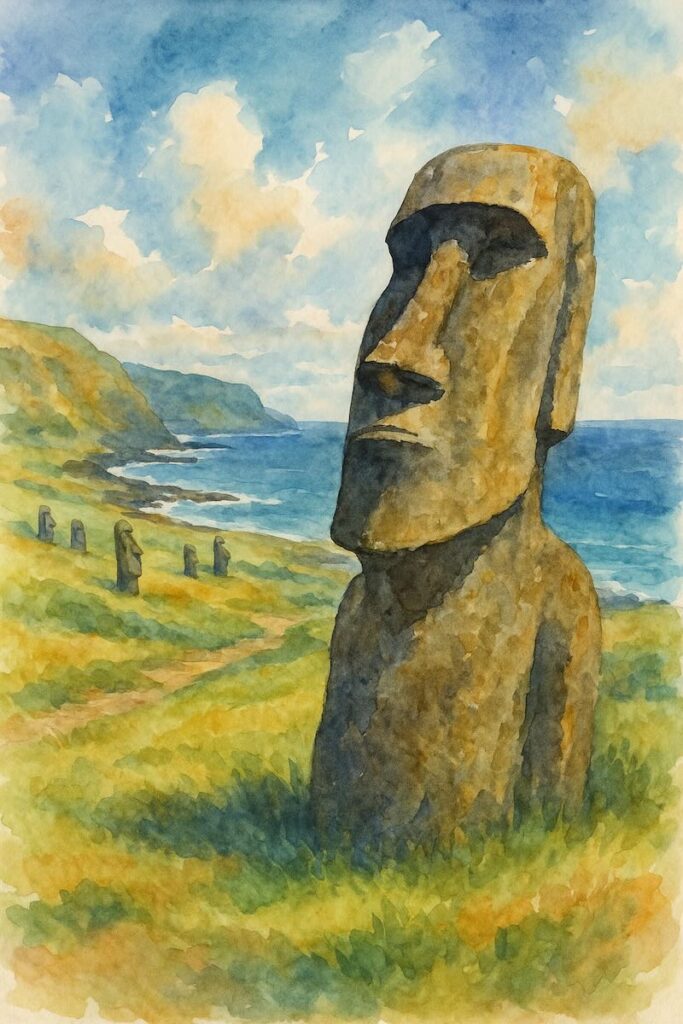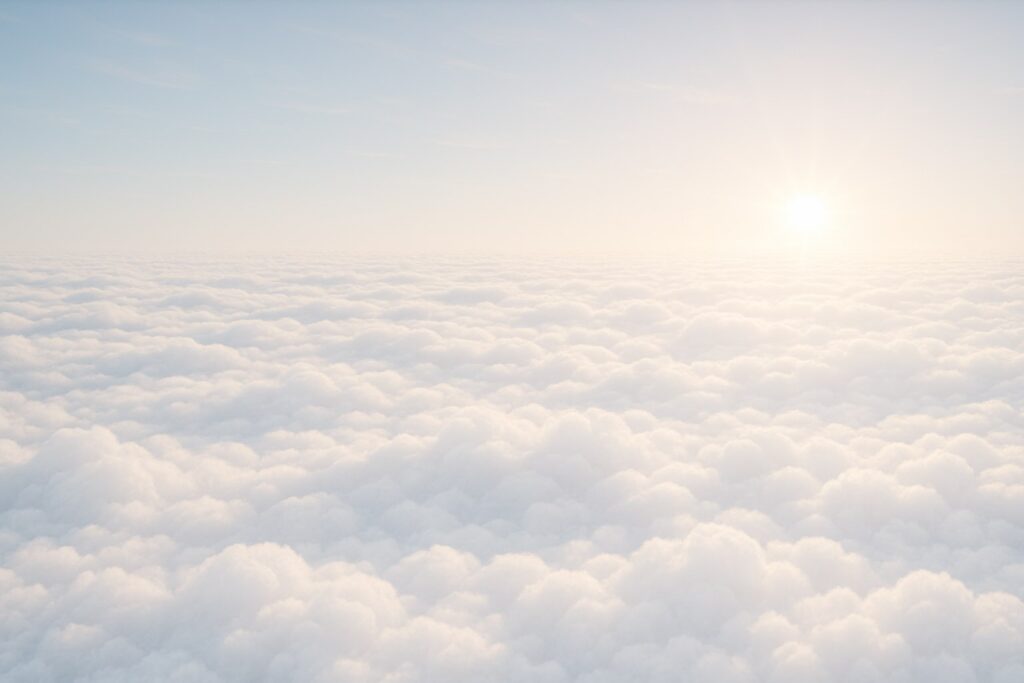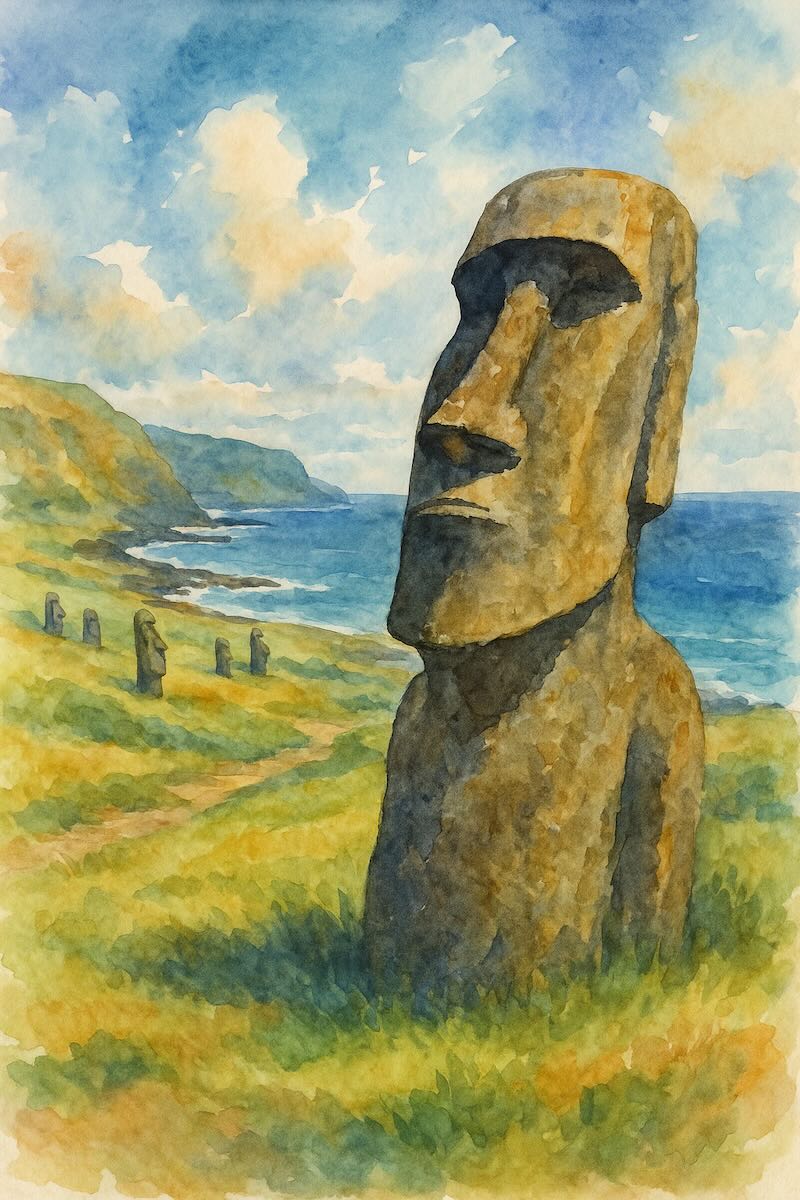Level 1 Reader
568 Words
A Small Island
Easter Island is a small island. It is in the Pacific Ocean. The island is very far from other places. It is part of the country of Chile. Not many people live there. It is quiet and peaceful. The weather is warm. There are green hills and blue sea.
A Special Name
Why is it called Easter Island? A man from Europe came to the island in 1722. He came on Easter Sunday. So, he called it Easter Island. The people on the island have another name. They call it Rapa Nui. That is the old name from the island’s people.
The Big Statues
Easter Island is famous for big statues. The statues are made of stone. They have big heads and long faces. Some have hats on their heads. These statues are called Moai. There are over 800 Moai on the island. Some are near the sea. Some are on hills. Some are very, very big.
Who Made the Moai?
Long ago, people lived on Easter Island. They were good builders. They made the Moai by hand. They used tools made of stone. They cut the Moai from big rocks. Then, they moved them to many places. They used ropes and wood to help. No one knows exactly how. People think the Moai are for family or leaders. They may be a way to say, “This is our land.”
A Long Time Ago
The Moai are very old. People made them many hundreds of years ago. But then, something changed. The trees on the island went away. People had no wood for houses or boats. Life became hard. There was not much food. Many Moai fell down. People stopped building them. But the Moai are still on the island today.
The People Today
Now, Rapa Nui people live on the island again. They speak Spanish and Rapa Nui. They have schools, shops, and homes. Many people visit the island. They come to see the Moai. Tourism is important for work and money. The people try to protect the land and statues.
A Place to Remember
Easter Island is a very special place. It has old history. It has strong people. It has big, stone faces looking at the sky. When you see the Moai, you remember the past. You think about the people who made them. You think about the land and the sea. Easter Island is small, but it is full of stories. It is a place to learn and to dream.
Save the Island
Easter Island is very old. The Moai are important. But wind and rain can hurt them. People want to keep the Moai safe. Some workers clean the statues. Some build walls to stop the sea. They take care of the land too. They plant trees and clean trash. The world helps Easter Island. Scientists come to study. Visitors learn to be kind to the island. We must protect Easter Island. It is a gift from the past.
Getting to the Island
Easter Island is far away. It is in the middle of the ocean. You cannot drive there. You cannot take a boat every day. Most people go by plane. The plane comes from Chile. It flies to the island in about six hours. There is only one small airport.
Level 2 Reader
500 Words
A Mysterious Island
Easter Island is a small island in the Pacific Ocean. It is far away from other places. The island belongs to Chile, a country in South America. The local name of the island is Rapa Nui.
Easter Island is famous for its giant stone heads. These statues are called moai. They were made a long time ago by the people of the island. No one knows exactly why they made them, but the statues are very special.
The Moai Statues
There are more than 800 moai statues on Easter Island. Some are very tall—over 10 meters high. They have big heads, long noses, and deep eyes. Many of the statues face inland, not the sea.
The moai were carved from volcanic rock. People used simple tools to cut the rock. Then, they moved the heavy statues to different places. No one is sure how they did it, because the moai are very heavy—some weigh more than 80 tons.
The People of Rapa Nui
The first people came to the island more than 1,000 years ago. They came by boat from other Pacific islands. They built homes, grew food, and made the moai. Life on the island was good for a long time.
But later, the island had problems. There were too many people. They cut down too many trees. There was not enough food. People began to fight. The island became a hard place to live.
A New Name
In 1722, a Dutch explorer found the island. He came on Easter Sunday, so he called it Easter Island. When the Dutch arrived, many moai had already fallen. Some were broken. The people of Rapa Nui had stopped making them.
Later, ships from Europe and South America came. Some people on the island were taken away. Others died from new diseases. The population became very small. At one time, only 111 people were left.
Saving the Island
Today, Easter Island is part of Chile. About 7,000 people live there. Many are descendants of the first Rapa Nui people. They speak Spanish and the Rapa Nui language.
Tourists come to see the moai and learn about the island’s history. But the island still has problems. It is small, and the land is fragile. Too many visitors can hurt the environment.
People on the island are trying to protect the land and the statues. They want to keep their culture alive.
A Special Place
Easter Island is one of the most remote places on Earth. It is also one of the most interesting. The moai are a symbol of the people’s past. They remind us of the power of human creativity—and also of the danger of using too many resources.
When people visit Easter Island, they learn not just about the past, but also about the future. The island teaches an important lesson: we must care for our planet before it is too late.
Level 3 Reader
542 Words
The Mystery of Easter Island
Far out in the southeastern Pacific Ocean lies one of the most remote inhabited islands in the world—Easter Island, or Rapa Nui, as it is known in the native language. Although it belongs to Chile, it is located more than 3,500 kilometers from the South American mainland. This small island, just 163 square kilometers in size, has captured the world’s imagination for centuries.
What makes Easter Island truly famous are its massive stone statues, called moai. These figures, some weighing more than 80 tons and standing over 10 meters tall, were carved from volcanic rock by the island’s early inhabitants. There are nearly 900 of them across the island. Most of them face inland, as if watching over the people.
But why were these statues made? How were they moved? And what happened to the civilization that built them? These questions continue to fascinate historians, archaeologists, and travelers alike.
A Thriving but Isolated Society
The first people are believed to have arrived on Easter Island around 1200 AD, likely from other Polynesian islands. They came by canoe, bringing with them plants, animals, and their way of life. At first, the island provided everything they needed—fertile soil, forests, and fresh water.
The population grew quickly, and with it, the culture flourished. The Rapa Nui people built villages, developed a unique writing system called rongorongo, and began carving the moai statues as a way to honor their ancestors and chiefs. The moai were placed on stone platforms called ahu, which were considered sacred.
Moving the moai was no simple task. Some experts believe they were “walked” across the island using ropes and a special rocking technique. Others think wooden sleds or rollers were used. Regardless of the method, the construction and transportation of the statues required incredible organization, teamwork, and resources.
Collapse and Contact
However, the island’s success eventually led to disaster. As more moai were built, more trees were cut down for tools, transportation, and firewood. Over time, deforestation became extreme. Without trees, the soil eroded, crops failed, and the people began to fight over limited resources. Wars broke out, and many moai were knocked over during conflicts.
When European explorers first arrived on Easter Sunday in 1722, the island was a shadow of its former self. The population had decreased dramatically, and much of the land was barren. Later, in the 19th century, slave traders took many islanders, and diseases brought by outsiders caused further suffering.
Despite these hardships, the Rapa Nui culture survived. Descendants of the original islanders still live on the island today. They continue to preserve their language, traditions, and deep spiritual connection to the moai.
Modern Easter Island
Today, Easter Island is a UNESCO World Heritage Site and a popular tourist destination. Visitors come to see the moai and learn about the island’s remarkable history. Efforts are being made to protect the statues and to reforest the land.
For many, Easter Island serves as both a warning and a wonder. It reminds us of the power of human creativity, but also the danger of using natural resources without care. The mystery of the moai may never be fully solved, but their silent presence continues to inspire and intrigue people around the world.
Extensive Listening
Level 1 Audio
Level 2 Audio
Level 3 Audio
Natural Discussion
AWS Polly & Google Notebook LM
La Isla de Pascua

Lectura nivel 1
544 Palabras
Una Isla Pequeña
La Isla de Pascua es una isla pequeña. Está en el Océano Pacífico. La isla está muy lejos de otros lugares. Es parte del país de Chile. No vive mucha gente allí. Es tranquila y silenciosa. El clima es cálido. Hay colinas verdes y mar azul.
Un Nombre Especial
¿Por qué se llama Isla de Pascua? Un hombre de Europa llegó a la isla en 1722. Llegó el domingo de Pascua. Por eso, la llamó Isla de Pascua. Las personas de la isla usan otro nombre. La llaman Rapa Nui. Ese es el nombre antiguo del pueblo de la isla.
Las Estatuas Grandes
La Isla de Pascua es famosa por sus estatuas grandes. Las estatuas están hechas de piedra. Tienen cabezas grandes y caras largas. Algunas tienen sombreros en la cabeza. Estas estatuas se llaman Moai. Hay más de 800 Moai en la isla. Algunos están cerca del mar. Otros están en colinas. Algunos son muy, muy grandes.
¿Quién Hizo los Moai?
Hace mucho tiempo, personas vivían en la Isla de Pascua. Eran buenos constructores. Hicieron los Moai a mano. Usaron herramientas de piedra. Cortaron los Moai de rocas grandes. Luego, los movieron a muchos lugares. Usaron cuerdas y madera para ayudar. Nadie sabe exactamente cómo. Las personas piensan que los Moai son para familias o líderes. Tal vez dicen: “Esta es nuestra tierra.”
Hace Mucho Tiempo
Los Moai son muy antiguos. Las personas los hicieron hace muchos cientos de años. Pero después, algo cambió. Los árboles de la isla desaparecieron. Las personas no tenían madera para casas o barcos. La vida se volvió difícil. No había mucha comida. Muchos Moai se cayeron. Las personas dejaron de construirlos. Pero los Moai todavía están en la isla hoy.
La Gente Hoy
Ahora, personas Rapa Nui viven en la isla otra vez. Hablan español y Rapa Nui. Tienen escuelas, tiendas y casas. Muchas personas visitan la isla. Vienen para ver los Moai. El turismo es importante para el trabajo y el dinero. Las personas tratan de proteger la tierra y las estatuas.
Un Lugar para Recordar
La Isla de Pascua es un lugar muy especial. Tiene historia antigua. Tiene personas fuertes. Tiene caras grandes de piedra mirando al cielo. Cuando ves los Moai, recuerdas el pasado. Piensas en las personas que los hicieron. Piensas en la tierra y el mar. La Isla de Pascua es pequeña, pero está llena de historias. Es un lugar para aprender y soñar.
Salvar la Isla
La Isla de Pascua es muy antigua. Los Moai son importantes. Pero el viento y la lluvia pueden dañarlos. Las personas quieren cuidar los Moai. Algunos trabajadores limpian las estatuas. Algunos construyen muros para parar el mar. También cuidan la tierra. Plantan árboles y limpian basura. El mundo ayuda a la Isla de Pascua. Científicos vienen a estudiar. Los visitantes aprenden a cuidar la isla. Debemos proteger la Isla de Pascua. Es un regalo del pasado.
Llegar a la Isla
La Isla de Pascua está muy lejos. Está en medio del océano. No se puede ir en coche. No se puede tomar un barco cada día. La mayoría de las personas van en avión. El avión viene desde Chile. Llega a la isla en unas seis horas. Hay solo un aeropuerto pequeño.
Lectura nivel 2
488 Palabras
Una Isla Misteriosa
La Isla de Pascua es una isla pequeña en el Océano Pacífico. Está muy lejos de otros lugares. La isla pertenece a Chile, un país de América del Sur. El nombre local de la isla es Rapa Nui.
La Isla de Pascua es famosa por sus grandes cabezas de piedra. Estas estatuas se llaman moai. Fueron hechas hace mucho tiempo por el pueblo de la isla. Nadie sabe con certeza por qué las construyeron, pero son muy especiales.
Las Estatuas Moai
Hay más de 800 estatuas moai en la Isla de Pascua. Algunas son muy altas—más de 10 metros. Tienen cabezas grandes, narices largas y ojos profundos. Muchas estatuas miran hacia el interior de la isla, no hacia el mar.
Los moai fueron tallados en roca volcánica. Las personas usaron herramientas simples para cortar la piedra. Luego, movieron las estatuas pesadas a distintos lugares. Nadie sabe con seguridad cómo lo hicieron, porque los moai son muy pesados—algunos pesan más de 80 toneladas.
El Pueblo de Rapa Nui
Los primeros habitantes llegaron a la isla hace más de 1,000 años. Vinieron en barco desde otras islas del Pacífico. Construyeron casas, cultivaron alimentos y crearon los moai. Durante mucho tiempo, la vida en la isla fue buena.
Pero con el tiempo, surgieron problemas. Había demasiadas personas. Cortaron muchos árboles. Faltaba comida. La gente empezó a pelear. Vivir en la isla se volvió difícil.
Un Nombre Nuevo
En 1722, un explorador holandés llegó a la isla. Era el domingo de Pascua, así que la llamó Isla de Pascua. Cuando llegaron los holandeses, muchos moai ya estaban caídos. Algunos estaban rotos. El pueblo Rapa Nui había dejado de construirlos.
Después, llegaron barcos de Europa y América del Sur. Algunas personas de la isla fueron llevadas lejos. Otras murieron por enfermedades nuevas. La población se redujo mucho. En un momento, solo quedaron 111 personas.
Salvar la Isla
Hoy en día, la Isla de Pascua es parte de Chile. Viven allí unas 7,000 personas. Muchas son descendientes del pueblo Rapa Nui original. Hablan español y también el idioma Rapa Nui.
Los turistas vienen a ver los moai y a aprender sobre la historia de la isla. Pero la isla todavía tiene problemas. Es pequeña, y la tierra es frágil. Demasiados visitantes pueden dañar el medio ambiente.
Las personas que viven allí están tratando de proteger la tierra y las estatuas. Quieren mantener viva su cultura.
Un Lugar Especial
La Isla de Pascua es uno de los lugares más remotos del mundo. También es uno de los más interesantes. Los moai son un símbolo del pasado del pueblo. Nos recuerdan el poder de la creatividad humana—y también el peligro de usar demasiados recursos.
Cuando la gente visita la Isla de Pascua, aprende no solo sobre el pasado, sino también sobre el futuro. La isla nos da una lección importante: debemos cuidar nuestro planeta antes de que sea demasiado tarde.
Lectura nivel 3
604 Palabras
El Misterio de la Isla de Pascua
Muy lejos, en el sureste del Océano Pacífico, se encuentra una de las islas habitadas más remotas del mundo: la Isla de Pascua, o Rapa Nui, como se le conoce en su idioma originario. Aunque pertenece a Chile, está situada a más de 3.500 kilómetros del continente sudamericano. Esta pequeña isla, de solo 163 kilómetros cuadrados, ha cautivado la imaginación del mundo durante siglos.
Lo que hace verdaderamente famosa a la Isla de Pascua son sus enormes estatuas de piedra, llamadas moai. Estas figuras, algunas de más de 10 metros de altura y con un peso superior a las 80 toneladas, fueron talladas en roca volcánica por los primeros habitantes de la isla. Hay casi 900 repartidas por toda la isla. La mayoría mira hacia el interior, como si protegieran al pueblo.
Pero ¿por qué se hicieron estas estatuas? ¿Cómo se trasladaron? ¿Y qué ocurrió con la civilización que las construyó? Estas preguntas siguen fascinando a historiadores, arqueólogos y viajeros por igual.
Una Sociedad Próspera pero Aislada
Se cree que los primeros pobladores llegaron a la Isla de Pascua alrededor del año 1200 d.C., probablemente desde otras islas de la Polinesia. Vinieron en canoas, trayendo consigo plantas, animales y su forma de vida. Al principio, la isla ofrecía todo lo necesario: suelos fértiles, bosques y agua dulce.
La población creció rápidamente, y con ella floreció la cultura. El pueblo Rapa Nui construyó aldeas, desarrolló un sistema de escritura único llamado rongorongo y comenzó a esculpir los moai para honrar a sus antepasados y líderes. Las estatuas se colocaban sobre plataformas de piedra llamadas ahu, consideradas sagradas.
Mover los moai no era tarea fácil. Algunos expertos creen que se “caminaban” utilizando cuerdas y una técnica especial de balanceo. Otros piensan que se usaban trineos o rodillos de madera. Sea cual sea el método, su transporte y construcción requerían una gran organización, trabajo en equipo y muchos recursos.
Colapso y Contacto Exterior
Sin embargo, el éxito de la sociedad terminó provocando su caída. A medida que se construían más moai, se talaban más árboles para herramientas, transporte y leña. Con el tiempo, la deforestación se volvió extrema. Sin árboles, el suelo se erosionó, las cosechas fracasaron y comenzaron los conflictos por los recursos limitados. Estallaron guerras, y muchas estatuas fueron derribadas durante las luchas.
Cuando los exploradores europeos llegaron por primera vez, un Domingo de Pascua en 1722, la isla era solo una sombra de lo que había sido. La población había disminuido de forma drástica, y gran parte de la tierra estaba agotada. Más tarde, en el siglo XIX, traficantes de esclavos se llevaron a muchos isleños, y las enfermedades traídas por los extranjeros causaron aún más sufrimiento.
A pesar de todas estas dificultades, la cultura Rapa Nui logró sobrevivir. Hoy en día, los descendientes de los habitantes originales aún viven en la isla. Conservan su idioma, sus tradiciones y una profunda conexión espiritual con los moai.
La Isla de Pascua Hoy
Actualmente, la Isla de Pascua es Patrimonio de la Humanidad por la UNESCO y un destino turístico muy popular. Los visitantes vienen para ver los moai y aprender sobre la historia extraordinaria de la isla. Se están realizando esfuerzos para proteger las estatuas y reforestar el entorno.
Para muchos, la Isla de Pascua representa tanto una advertencia como un símbolo admirable. Nos recuerda el poder de la creatividad humana, pero también el peligro de explotar los recursos naturales sin cuidado. El misterio de los moai quizá nunca se resuelva del todo, pero su presencia silenciosa continúa inspirando e intrigando a personas en todo el mundo.
Escucha extensiva
Nivel 1 audio
Nivel 2 audio
Nivel 3 audio
Discusión natural
AWS Polly & Google Notebook LM


